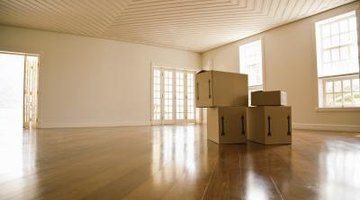How to Fix a Crowning Joist
A joist is a structural component of a building. It can be wood, steel or concrete, and run between any combination of walls and beams. Beams, the horizontal structural elements, are usually larger than joists and support them. Wood used in the joists and framing of a building responds to changes in temperature and humidity by shrinking and bending, and traditional natural lumber is rarely straight. A crowning joint is one that arches upwards. This is a common feature in poorly installed floors.

Step 1
Check the floor area with the level to find the highest point. This point is the top of the joist crown. Move one end of the level to different points around the floor, keeping the other end on the crown. Measure and note the gap between the floor and the ends of the level at each point.
Step 2
Mark the highest point of the crown -- the bulge -- on the floor. Measure the distance of that point to a feature such as a wall or heating duct that extends to the floor below. Ensure that a line from the bulge to the feature meets the feature at a right angle.
Step 3
Go to the floor below. Measure the same distance as on the floor above from the chosen feature underneath the joists. Ensure that a line from the feature underneath the joists starts at the same right angle as on the floor above. Mark this point on the underside of the joist. This will be directly below the highest point of the crown on the problem joist.
Step 4
Make a straight cut into the problem joist at the mark just below the high point with the reciprocating saw. Ensure that the cut reaches a depth of three-fourths of the joist depth.
Step 5
Wait for several weeks and allow the joist to relax and straighten. Check the bulge with the level as it falls. Do not load the floor above with any excessive weight.
Step 6
Nail the board to the underside of the joist when the floor has settled. Hammer 16d common nails in pairs staggered 12 inches apart. Drive a row of three nails on either side of joist cut. This fixes the crowning joist.
References
Tips
- Use engineered lumber for joists to avoid crowning if building a floor or frame from scratch. Engineered wood is not as sensitive to humidity and temperature as natural wood.
Warnings
- Planing the crown from the top of the joist thins the board and reduces its bearing strength. Consult a structural engineer before trying this method.
Writer Bio
Based in London, Maria Kielmas worked in earthquake engineering and international petroleum exploration before entering journalism in 1986. She has written for the "Financial Times," "Barron's," "Christian Science Monitor," and "Rheinischer Merkur" as well as specialist publications on the energy and financial industries and the European, Middle Eastern, African, Asian and Latin American regions. She has a Bachelor of Science in physics and geology from Manchester University and a Master of Science in marine geotechnics from the University of Wales School of Ocean Sciences.
Photo Credits
- Jupiterimages/Creatas/Getty Images
More Articles



